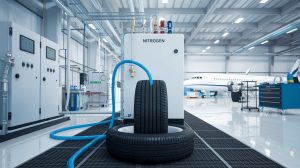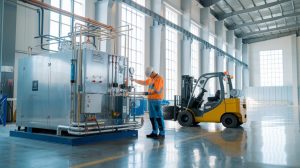In today’s industrial scenario, nitrogen has become more or less essential for various operations in various industrial verticals. Earlier, they had used outsourcing nitrogen in which they had to be transported and stored, and the management of which was a big problem. However, those limitations have been erased with the recent possibilities of onsite nitrogen generation that makes all the difference with costs, efficiency, and sustainability at an industrial level. Since nitrogen generation is produced on site, it is considerably more convenient, and the capability is growing evermore popular in industries that consist of food and beverages, electronics, pharmaceuticals, and manufacturing.
This article will provide an introductory overview of onsite nitrogen generation, focus on PSA nitrogen generators and high-pressure nitrogen generators, and evaluate the industries that will find this solution most beneficial.
What Is Onsite Nitrogen Generation?
Onsite nitrogen generation is a technological process whereby nitrogen is generated at the user’s premise, in addition to other supply technologies. Instead of using deliveries of nitrogen cylinders or liquid nitrogen, businesses may use nitrogen-producing equipment that extracts nitrogen from the air. Its main benefits are as follows: it cuts transportation costs and guarantees the nitrogen supply at any time and in any necessary quantities.
Why Is Nitrogen Important Across Industries?
Nitrogen is a n-element that is typically colorless and odorless and is chemically inactive at normal temperature and pressure. This characteristic makes it useful in processes that, for one or the other reason, would not be safe or possible in an oxygen environment. For instance, in the food industry, it helps to preserve products properly, and in the pharmaceutical industry, assisting in guarding vulnerable reactions. In the electronics industry, nitrogen has been used further to create an environment that does not cause the products under production to get oxidized. The utilization of nitrogen generation systems thus gives the industries some measure of convenience in nitrogen generation, such as application-specific production.
Understanding PSA Nitrogen Generators
The two common nitrogen generation systems are Pressure Swing Adsorption (PSA) nitrogen generators. PSA refers to a process applied to the removal of nitrogen contained in the air. This type of generator is particularly useful for generating nitrogen for use in processes that require high-purity nitrogen. The generator affords a steady stream of nitrogen that is completely free of contaminants.
How PSA Technology Works
The PSA process starts by performing the initial step of introducing outside air. This is usually composed of approximately 78 percent nitrogen, 21 percent oxygen, and a small amount of other gases present in the air. In a PSA nitrogen generator, this air is compressed and then passed through the adsorption columns, which contain adsorbent material like carbon molecular sieves. These various materials can adsorb oxygen molecules while selectively passing nitrogen. At the optimum production limit, where the adsorption columns are fully saturated with oxygen, these adsorption columns are purged so that more oxygen can be adsorbed. This pressure-based swing cycle enables the generator to deliver a constant stream of nitrogen.
These features of this system increase its efficiency, reliability, and capacity to supply high-purity nitrogen, making PSA nitrogen generators a more economical option for many companies. Various institutions like the Compressed Gas Association (CGA) have produced some standards that have provided the maze on the right and proper way of deploying this PSA nitrogen generation technology across the globe since it has turned out to be essential to many industries.
Advantages of High-Pressure Nitrogen Generators
However, while PSA nitrogen generators are appropriate for most uses, some industries demand nitrogen with a high enough pressure that a high-pressure nitrogen generator is more suitable. High pressure nitrogen generator supply nitrogen pressure that is higher than normal pressure systems, eliminating the necessity for other compressors or pressurization equipment.
High-Pressure Generators for Specialized Applications
Oil and gas, metal fabrication industries, and aerospace utilize high-pressure Nitrogen for functions such as pipeline purging, protection of sensitive environments like storage tanks, and pressure testing of equipment. High-pressure Nitrogen is another example; having an onsite high-pressure nitrogen generator means the company can supply their high-pressure directly, which means no more having to deal with storage tanks or additional equipment. Moreover, it eliminates the risks of having to store large volumes of high-pressure gaseous Nitrogen and makes safety from pressure across the site better.
High-pressure nitrogen generation solutions prove to be cost-effective in the long run since these generators are not as affected by transportation costs and losses and can regulate pressure much better than other types of generators in use today.
Industries Benefiting from Onsite Nitrogen Generation
Onsite nitrogen generation is highly useful for multiple industries because it has several advantages compared with other methods for nitrogen supply. Below are some of the primary sectors that benefit from this technology:
Food and Beverage Industry
The primary reason Nitrogen is used in the food and beverage industry is in modified atmosphere packaging (MAP), whereby Nitrogen is used to replace oxygen, which speeds up the spoiling of products. Another use of Nitrogen is to use it as a filling medium in packages, pushing out air in the bags and thereby shielding the contents from environmental degradation. Onsite nitrogen generation also enables food and beverage companies to generate Nitrogen at the point of use, thus enjoying the benefit of nitrogen quality they require without being limited by external nitrogen providers.
Electronics Manufacturing
In electronics, Nitrogen has made a pivotal contribution in ensuring that products do not contact oxygen during production processes like soldering and assembly. Nitrogen is generated onsite through an onsite nitrogen generator, which aids manufacturers in preventing oxidation and meeting set quality standards. The important body of standards for electronics manufacturing nowadays is the Institute of Electrical and Electronics Engineers (IEEE), which advises the use of high-purity Nitrogen in technological processes to decrease the level of contamination.
Pharmaceuticals and Life Sciences
Nitrogen is used in pharmaceutical and life sciences production processes for blanketing, purging, and maintaining a sterile environment. Offering nitrogen generation guarantees that nitrogen gas is available whenever it is required. It helps meet high standards of hygiene and safety. Some regulatory organizations, like the Food and Drug Administration (FDA), have encouraged manufacturers to adopt controlled environments. This makes onsite nitrogen generation useful in pharmaceutical manufacturing environments.
Oil and Gas Industry
In the oil and gas industry, nitrogen’s key application is in well drilling, as well as maintenance and purging pipelines. High-pressure nitrogen generation systems help oil and gas majors generate nitrogen at the required pressures at the site, thereby avoiding the transport of nitrogen under high pressure. They are also very safe. Onsite nitrogen generation also assists firms in this sector to meet the legal requirements on environmental concerns since the process avoids releases of nitrogen through pipeline transport.
Key Benefits of Onsite Nitrogen Generation
- Cost Savings: Onsite nitrogen generation helps save the costs associated with the transportation, storage, and handling of this gas. Given its efficiency in energy utilization, PSA nitrogen generator have low carrying costs.
- Environmental Impact: The onsite generation of nitrogen is a bit eco-friendly because there is extra hauling of nitrogen tanks, which are disposed of for reuse.
- Continuous Supply: In this way, companies can generate nitrogen at the workplace, which means that there will be no disruptions in the nitrogen supply and, therefore, no interruptions in production.
- Quality Control: Onsite generation also ensures that the business has control over the purities of the nitrogen generated, especially when used in sensitive applications such as the manufacture of drugs and the electronic industry.
Frequently Asked Questions (FAQs)
Q1: What is the difference between PSA nitrogen generators and membrane nitrogen generators?
A1: This is particularly so because PSA nitrogen generators use pressure-based adsorption to separate nitrogen and obtain high-purity nitrogen gas. Membrane generators use selectivity, but they provide relatively lower-purity nitrogen than PSA systems.
Q2: How does onsite nitrogen generation compare to nitrogen cylinders in terms of cost?
A2: The nitrogen stored for long-term use would be generated onsite, making it more economical in terms of recurring costs of renting cylinders, delivery, and storage.
Q3: How often should a PSA nitrogen generator be maintained?
A3: Routine service, which includes a filter and adsorbent check, is advised after every one year or six operating hours, but it can be as long as one year apart on average. The manufacturer’s maintenance schedule should be followed to follow the optimal practice for the maintenance schedule.
Q4: Is onsite nitrogen generation scalable for different business sizes?
A4: Yes, nitrogen generation systems can be ordered in different capacities, which is why they can be used in small businesses and big factories.



